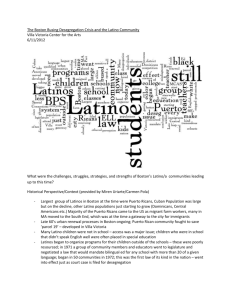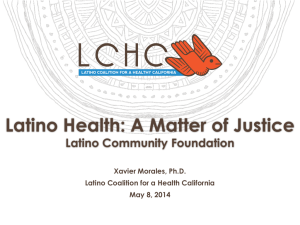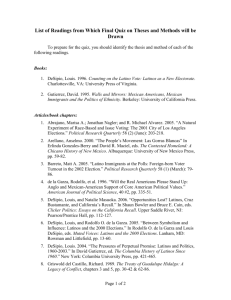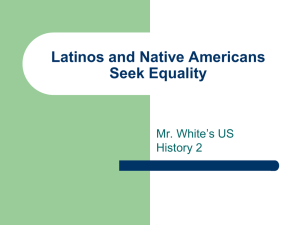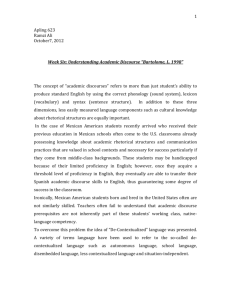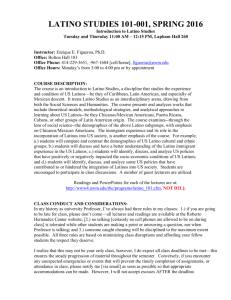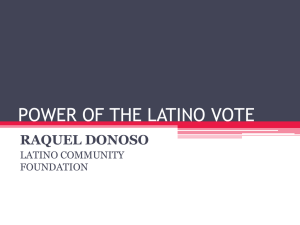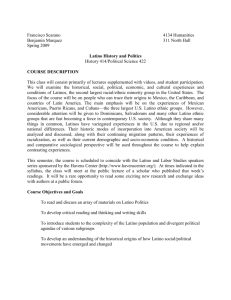Financial Literacy and College Access: Understanding the
advertisement
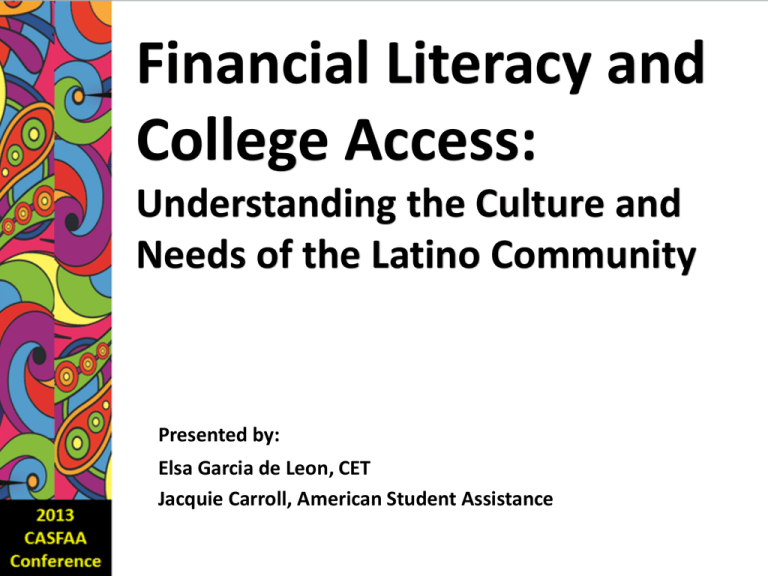
Financial Literacy and College Access: Understanding the Culture and Needs of the Latino Community Presented by: Elsa Garcia de Leon, CET Jacquie Carroll, American Student Assistance Agenda • Understanding culture • Latino barriers to higher education • Implications for action Para ti! • Que quieres sabes? UNDERSTANDING CULTURE Cultural Background Education Investment Family History of Financial Institutions • Consider the history the countries of origin of the Latino community. • Distrust of banks – exacerbated by overall confidence in stability of financial institutions. Perspective • Potential for distrust of institutions – financial, educational, government. • High percentage of first generation college students. – Young adults look to siblings, peers, relatives for information. – More likely to not be informed (or be misinformed) about financial aid opportunities. History of Educational Institutions • The educational system is slowly developing. Country % Higher Education Coverage • Colombia • Chile • Mexico • 35% • 32% • 25% • Europe • Asia • USA • 82% • 67% • 62% Hispanic Educational Attitudes • Hispanic young adults are more likely to voice concerns about getting enough money to go to college. – Less than half believe qualified students can find a way to pay for college. – Over half who go to college say they would have gone to a different college or university if money hadn’t been an issue. Source: A Matter of Trust: 10 Key Insights from Recent Public Opinion Research on Attitudes About Education among Hispanic Parents, Students and Young Adults Public Agenda, May 2008 LATINO BARRIERS TO HIGHER EDUCATION Latinos and Financial Aid • Three out of four respondents who did not attend college cited lack of financial aid as a factor. • Less than 49% of respondents who did not attend college had heard of the Pell Grant compared to 80% who did attend. • Less than 20% have an accurate perception of costs to attend UC or CSU systems. Most respondents over-estimated the cost. Source: Perceptions of College Financial Aid Among California Latino Youth Tomás Rivera Policy Institute, June 2006 Latinos and Financial Aid • Familiarity with financial aid varies among immigrant groups and national origin. – 30% of first generation are somewhat familiar versus 51% third generation. – 36% Mexican are somewhat familiar versus 47% Puerto Rican. Source: A National Survey of Latino Perspectives on Financial Aid SallieMae Fund & Tomás Rivera Policy Institute, March 2004 Latinos and Financial Aid • 3/4 of young adults NOT currently in college would have been more likely to attend college if exposed to better information about financial aid. • More than half of all Latino parents and 43% of Latino young adults could not name a single source of financial aid. • Approximately 20% of parents and young adults preferred financial aid information in both English and Spanish. Source: A National Survey of Latino Perspectives on Financial Aid SallieMae Fund & Tomás Rivera Policy Institute, March 2004 Latinos and Financial Aid • More than half of all survey respondents believed that a student must be a U.S. citizen in order to apply for financial aid. – 1 in 4 respondents believes parents need to be U.S. citizens in order for students to apply for aid. First Gen & Undocumented Barriers First Generation & Latino Students - Difficulty borrowing money - Believe they cannot receive financial aid - Few opportunities for steady employment - Limited scholarship opportunity (not as prepared) - Non-tuition expenses Undocumented Students - Lack of information about federal loans, federal grants, and private loans - Lack of bilingual & bicultural staff - Parent concerns - Fear deportation - Poverty - Fear of the unknown - Differing school norms - Language barriers - Psychological - Painful memories - Hiding real self - Hopelessness Undocumented Students Washington Vermont Montana North Dakota Maine Minnesota Oregon New Hampshire Wisconsin New York South Dakota Idaho Rhode Island Connecticut Michigan Wyoming Pennsylvania Iowa New Jersey Nebraska Ohio Nevada Illinois Utah Colorado California Kansas Massachusetts Indiana West Virginia DC Delaware Maryland Virginia Missouri Kentucky North Carolina Tennessee Arizona Oklahoma Arkansas South Carolina New Mexico Alabama Mississippi Georgia State Law Louisiana Texas Florida Alaska Hawaii Puerto Rico and U.S Virgin Islands Higher Education Board Policy CA Dream Act AB 540 – 2001 • Assembly Bill 540 (Firebaugh, 2001) created the first state authorized benefit for undocumented students in California – exemption from nonresident tuition at public postsecondary institutions AB 130 – July 2011 • Private scholarships can be administered by public colleges AB 131 – October 2011 • State funded grants including Cal Grants AB540 • Students who are undocumented • Students who are U.S. citizens, but who are not CA residents • Usually dependent students living in the state whose parents are not CA residents • Sometimes former CA residents • In any case, the students must meet the AB 540 criteria on the previous slide CA Dream Act Resources Undocumented Students • HB1079 – Washington (2003) – Allows undocumented students to pay in-state tuition at state colleges and universities. – Must reside in WA for the 3 years immediately prior to receiving a high school diploma, and completed the full senior year at a WA high school (or equivalent). – Continuously resided in state since receiving diploma or equivalent. • HB2737 – Oregon (2013) – In-state tuition at 7 state universities for undocumented students who have studied in an Oregon school for 3 years and graduated; – Must have attended school in the US for at least 5 years. – Must plan to become a resident of the US. IMPLICATIONS FOR ACTION Profile of Latino Undergrads • Majority of Latino undergraduates enrolled in college in 2003-04 were traditional college-age and financially dependent on parents. They varied from all other undergraduates in that they were more likely to be: – – – – First-generation (almost 50% versus 30%) Living with parents (1/3 compared to less than 1/4) Enrolled part-time In households with relatively low incomes (25% under $40,000 compared to 16%, and 25% under $20,000 versus $16%) – In EFC range of $1000 or less (42% compared to 30%) Source: How Latinos Pay for College: Patterns of Financial Aid in 2003-04 Excelencia in Education and the Institute for Higher Education Policy, August 2005 Latino College Choices • Latinos are significantly less likely than Anglos to graduate from a research-intensive university and significantly more likely to graduate from a master’s university. Source: College Choices Among Latinos: Issues of Leaving Home Tomás Rivera Policy Institute, June 2003 Latino College Choices • Overall males are more likely than females to graduate from a research intensive university. – Latinas are significantly less likely than Anglo females to graduate from a research intensive university. Source: College Choices Among Latinos: Issues of Leaving Home Tomás Rivera Policy Institute, June 2003 How Latino Students Pay for College • Almost 80% applied, of which 63% received some form of aid. • Overall, Latinos received the lowest average financial aid award ($6,250) than all ($6,890). • Overall, more likely to receive grants (50%) than loans (30%). • By sector, public two-year and four-year: – At two-year, less likely to receive aid (43% versus 47%). – At four-year, more likely to receive aid(75% versus 68%). Source: How Latinos Pay for College: Patterns of Financial Aid in 2003-04 Excelencia in Education and the Institute for Higher Education Policy, August 2005 Educational Desires • Through expert – in a community center (not official “institution”) • In language-specific workshops with languagespecific materials • New counseling tools – – – – Step-by-step Personalized Different modes of information Tangible ideas about process and goals CET Case Study Staffing • Bilingual Bicultural Financial Aid Counselor • Understand parent/student relationships • It is about jobs Actions • • • • • Get in to the community Establish mentoring opportunities Provide information in English and Spanish Involve students and parents Address information gap in college pricing and affordability THANK YOU! Elsa Garcia de Leon, CET ewellsgarcia@eei.edu Jacquie Carroll, American Student Assistance jcarroll@asa.org

